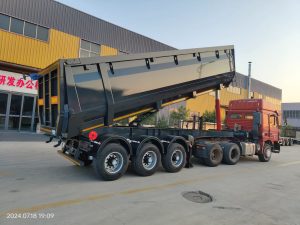
Self-dumping semi-trailers are widely used in construction, mining, logistics and other industries due to their efficient loading and unloading capabilities. In the actual transportation process, in order to ensure safety and improve efficiency, it is necessary to follow a series of operational specifications. In this article, we will introduce the precautions for the transportation of self-discharging semi-trailers in detail, which will help enterprises optimize the transportation process and reduce the occurrence of accidents.

Self-Dumping Semi-trailers
1. Choosing the right tipper semi-trailer
When choosing a self-discharging semi-trailer, the model should be decided according to the type of goods, transportation distance and road conditions. For example:
U-type carriage: suitable for loose materials, unloading more thoroughly.
Box-type carriage: suitable for transportation of block or heavier goods, preventing the goods from falling apart.
Lightweight semi-trailer: adopts high-strength steel, reduces self-weight and improves carrying capacity.
Rear-turned and side-turned compartments: rear-turned is suitable for general road transportation, and side-turned is suitable for mining area or special unloading requirements.
2. Cargo loading requirements
Correct loading method can avoid tipping and damaging the wagon:
Cargo should be evenly distributed and the center of gravity should be kept in the middle of the compartment.
Prohibit overloading and ensure that the vehicle operates within the rated load.
Check the fixation of cargo to prevent shifting during transportation.
Avoid mixing different types of cargo to minimize damage to the wagon.
3. Precautions for driving safety
During traveling, drivers of self-dumping semi-trailers should pay attention to the following matters:
Avoid speeding: when driving at high speed, the stability of the vehicle is reduced and it is easy to overturn.
Pay attention to the road conditions: driving on the slope or muddy roads, should reduce the speed, to prevent the vehicle from skidding or rollover.
Maintain a safe distance: Ensure sufficient braking distance to avoid emergency braking leading to forward movement of cargo.
Check the brake system of self-dumping Semi-trailers: especially on downhill sections, slow down in advance and use the engine brake to reduce the risk of brake failure due to overheated brake pads.
4. Unloading operation standardization
Correct unloading operation can help improve efficiency and reduce damage:
Make sure the vehicle is parked on solid, level ground to avoid tipping over.
Before unloading, the driver of self-dumping Semi-trailers should leave the driver’s cab and observe the surrounding environment to see if it is safe.
The lift hydraulics should be operated slowly to prevent danger from sudden discharge.
After unloading, the carriage should be completely lowered and locked to prevent accidents during traveling.
When encountering sticky goods, such as wet soil or slag, the tilt angle of the carriage should be adjusted appropriately to ensure smooth unloading.
5. self-dumping Semi-trailers Maintenance
Regular maintenance can prolong the life of the vehicle and reduce the failure rate:
Check the hydraulic system: make sure there is no leakage in the cylinder and sufficient hydraulic oil.
Tire inspection: Maintain proper tire pressure to prevent tire blowout.
Brake system maintenance: Check brake pads and brake fluid regularly to ensure good braking effect.
Cabin fastening check: avoid loosening of bolts due to vibration during transportation.
Check the electrical system: make sure the lights and signals work properly to prevent safety hazards during nighttime driving.
6. Comply with local transportation regulations
Different countries have different laws and regulations on the transportation of self-dumping semi-trailers, which should be known and obeyed in advance:
Know the local load limit and road regulations.
Ensure that the tipper semi-trailer has the necessary transportation permits.
Install the necessary safety markings, such as reflective strips, guard rails, etc., according to the regulations.
In some areas, additional environmental requirements may be required, such as tailpipe emission standards, which should be known and prepared for in advance.
7. Dump semi-trailer driver training and emergency response
Good driving skills and emergency response capabilities are critical to semi-trailer transportation:
Train drivers regularly to improve their ability to cope with complex road conditions.
Educate drivers to operate the hydraulic system correctly to avoid damage due to operation errors.
Develop emergency plans, such as measures to deal with situations such as loss of vehicle control and brake failure.
Equip necessary safety equipment, such as fire extinguishers, warning signs, etc., in case of emergency.
Conclusion
Self-dumping semi-trailers play an important role in modern logistics transportation, and proper operation and maintenance can not only improve transportation efficiency, but also effectively reduce the accident rate. Through reasonable selection of vehicles, follow the loading and unloading specifications, safe operation and regular maintenance, enterprises can better optimize the tipper semi-trailer transportation process to ensure long-term safe and stable operation.
For more professional advice on self-dumping semi-trailers, please visit Patec Trailer.






Post a Comment